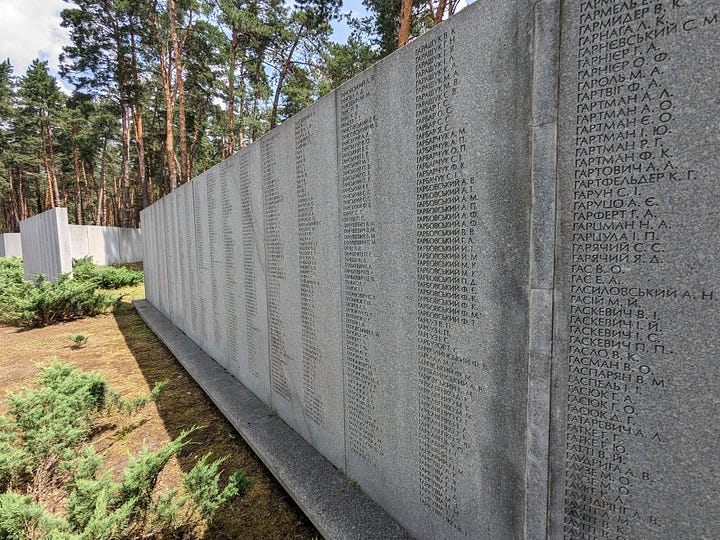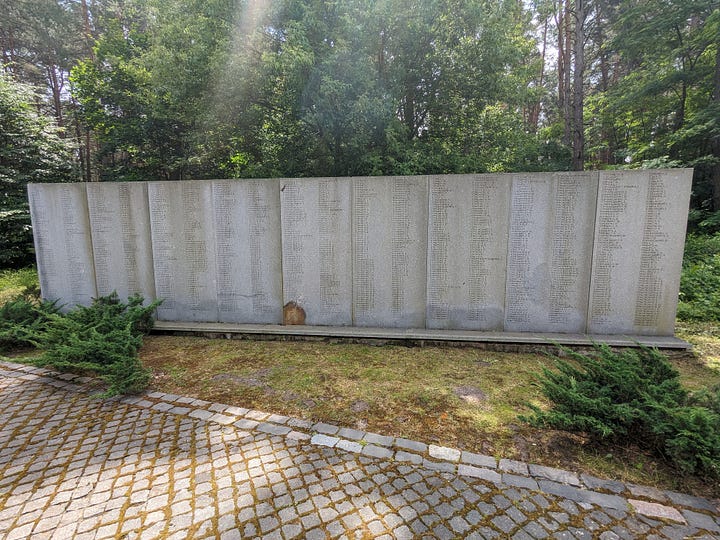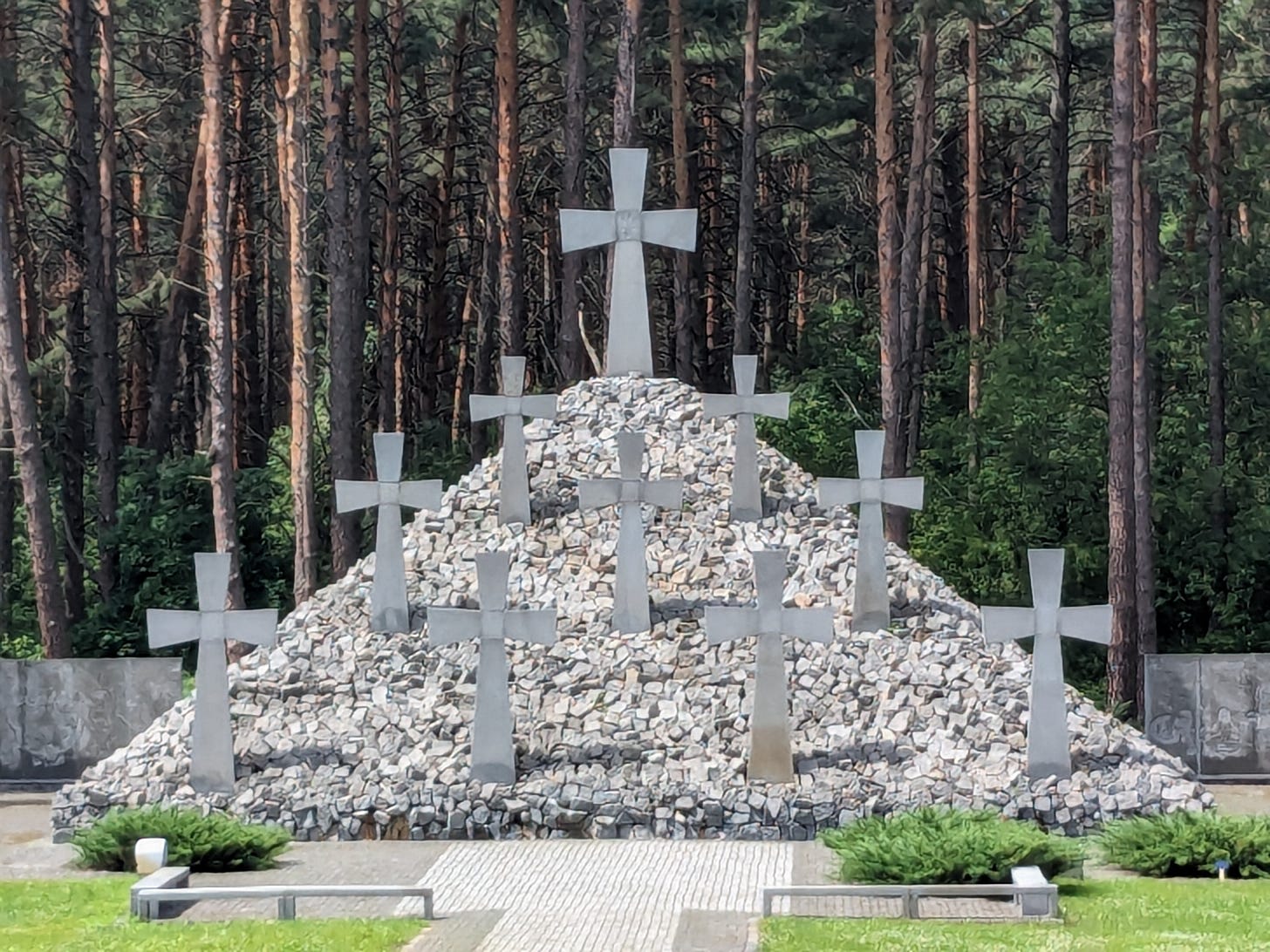Lessons from a place of tranquil horror
How a mass grave from Stalin’s time helps explain Ukraine’s reluctance to negotiate with Putin
The Bykivnya Memorial in Kyiv occupies the center of a 12-acre expanse where Joseph Stalin’s secret police dumped an estimated 40,000 to 60,000 bodies — and possibly as many as 120,000 — between 1937 and 1941. (c. Martin Kuz)
Independence Monument ascends into the sky in the heart of Kyiv as a symbol of Ukraine’s freedom. Atop a white marble column stands a bronze statue of Berehynia, the Slavic goddess of life and protection, who gazes toward the horizon with arms raised overhead. In her hands she holds a guelder rose, an emblem of Ukrainian nationhood, a status the country officially gained only in 1991 and now in grave jeopardy.
More than 200 feet below her soaring presence, across a gentle slope that fronts the monument, a makeshift shrine honors the mortal guardians of liberty. Thousands of small Ukrainian flags blanket the grass, each blue and yellow rectangle representing a soldier killed since Russia launched its full-scale invasion in early 2022. Unlike Berehynia, mythical and invulnerable on her pedestal high above, the memorial reflects war’s earthly aspect, its human toll: another flag planted, another life lost.
The growing number of Ukrainian casualties — troops and civilians alike — has amplified calls from some Western allies for President Volodymyr Zelensky to trade land for peace. A clear majority of Ukrainians continue to reject that idea even as they bear the heaviest burdens and deepest anguish inflicted by an invasion grinding toward its 1,000th day. A survey from a Ukrainian pollster published in August found that 77 percent oppose freezing the front line and ceding all occupied regions to Russia; nearly as many disapprove of abandoning efforts to join NATO and the European Union as a precondition for ending the war.
One reason for their stubborn resolve derives from collective remembrance of Moscow’s history of mass killing in Ukraine. Only one or two generations separate most of them from the barbaric regime of Joseph Stalin, the Soviet dictator who, during three decades in power, starved and executed at least 6 million Ukrainians before his death in 1953. Seven miles from where Berehynia rises over the land in tribute to the country’s independence, evidence lies beneath the soil of that past Russian tyranny.
A statue of a peasant marks the entrance to the memorial. (c. Martin Kuz)
A bronze statue of a peasant standing with his head bowed and hands clasped marks the entrance to a gravel road that branches off the highway leading northeast out of Kyiv. The lane wends through the Bykivnya Forest beneath towering pines, with thin blue and yellow ribbons ringing the trunks of the trees that line the path. After a half-mile, the route reaches a clearing loosely encircled by granite slabs engraved with 18,000 names, an incomplete index of victims buried in this place of tranquil horror.
Stalin’s security service, the NKVD, carried out executions with malign efficiency in prisons and detention facilities in Kyiv and other major cities in Ukraine from the late 1920s through the end of his reign. The Bykivnya Memorial occupies the center of a 12-acre expanse where his secret police dumped an estimated 40,000 to 60,000 bodies — and possibly as many as 120,000 — between 1937 and 1941.
Soviet authorities targeted intellectuals — scientists, politicians and priests; journalists, artists and academics — and often their family members, friends and casual associates. The NKVD labeled them enemies of the state for insufficient fealty to Moscow rooted in their abiding belief in Ukrainian identity and nationhood.
Stalin’s purge of dissidents during the Great Terror from 1936 to 1938 claimed 1 million lives across the Soviet Union. The toll included 200,000 victims in Ukraine, where he had starved 4 million people to death as the decade dawned. In Kyiv, the NKVD murdered upward of 100 people a day with one to two gunshots to the head, hauling the dead in enclosed trucks to the Bykivnya neighborhood under cloak of night. In the forest, disposal crews hurled the bodies into pits filled with lime.
The police installed an 8-foot-high wooden fence topped with razor wire around the mass grave to conceal the dark truth from residents. The ambient threats of arrest, torture, exile and execution that pervaded the Soviet Union under Stalinism deterred them from wondering aloud about the site’s purpose. Still, as Dutch historian Karel Berkhoff reported in 2015, they noticed disturbing details:
Locals who at first suspected that weapons were stored behind the mysterious fence did [grow suspicious]. In the mornings, herdsmen would find objects that had fallen off the trucks. Moreover, as a local woman recalled in 1988, “on the road leading toward the gate of that fence we saw bloody spots. Many saw those bloodstains, but were afraid to talk about them.”
Word spread about the burial ground during and after World War II, drawing grave robbers who scavenged for gold teeth and crowns, jewelry, clothes and shoes. In the decades following Stalin’s death, as Moscow alternately loosened and tightened its repressive policies, Soviet authorities neither revealed Bykivnya’s secret in full nor preserved the site’s physical integrity. The KGB, the NKVD’s successor agency, conducted a few slipshod excavations and reburials before grading the soil with heavy equipment that pulverized and dispersed bones and skulls. Looting never ceased.
The scale of the tragedy began to emerge at the turn of the century following the Soviet Union’s collapse in 1991. Ukrainian officials gained access to a portion of the NKVD archives and discovered records that identified men, women and children discarded in mass graves throughout the country. Researchers corroborated the names through interviews with relatives and witnesses, along with limited exhumations and forensic analysis as funding and site conditions allowed.
A presidential decree established the Bykivnya Memorial in 1994. The 18,000 identified bodies in the forest — thrown into more than 200 separate pits — included 3,000 soldiers and civilians from Poland, and smaller numbers from Germany, Belarus, Bulgaria and other nations. Another 1,200 were NKVD officers.
Ukrainian civilians accounted for the largest share of the dead and ranged from professors to factory workers, farmers to homemakers. One of the brightest cultural lights extinguished was Mykhailo Boychuk, a painter and muralist regarded as the pioneer of monumentalism in Ukraine. Best known for his religious icons, portraits of peasants and scenes of rural life, he cofounded the country’s first post-secondary art school in Kyiv in 1917.
Twenty years later, the NKVD tortured and shot Boychuk, 54, after accusing him of promoting “bourgeois nationalism” in his art and the classroom. His wife and at least four of his students suffered the same fate. The authorities destroyed most of his frescoes, mosaics and paintings, attempting to erase his legacy. In death, he joined the Executed Renaissance, the doomed generation of Ukrainian artists and thinkers — several hundred in all — who perished in Stalin’s genocide.
A school of art and design named for Boychuk opened in Kyiv in 1999. A campus museum devoted to his creative spirit displayed works by artists whose style and motifs evoked his own. On a Monday morning this spring, with classes underway, a missile strike leveled the section of the academy that housed the museum. Long after murdering Boychuk, Moscow seemed to want to kill his very memory, compelled by a new Russian despot pursuing a new Ukrainian genocide.


The memorial walls at Bykivnya are engraved with the names of 18,000 identified victims. (c. Martin Kuz)
President Zelensky and First Lady Olena Zelenksa attended a brief ceremony at the Bykivnya Memorial two months after the attack on the school. The couple visited the site to observe Ukraine’s annual Day of Remembrance of the Victims of Political Repression, when the country honors the millions of lives stolen by the Soviet empire. In twisted homage to Stalin’s imperialist fantasies, Vladimir Putin has exhumed that history of mass death, saturating Ukraine’s rich soil with the blood of innocents.
The official number of Ukrainian civilians killed in the Russian dictator’s unprovoked war has almost eclipsed 12,000 — a census of the dead broadly viewed as nowhere close to accurate. Casualties remain largely uncounted in the 20 percent of Ukrainian territory that Russia controls beyond the reach of Western investigators. In a single occupied city, the presumed death toll exceeds the verified nationwide total: Ukrainian officials and human rights groups estimate that some 20,000 civilians died during the siege of Mariupol early in the invasion.
Putin’s troops have dug fresh mass graves across Ukraine, tortured and disappeared thousands of Ukrainians from occupied areas and abducted more than 19,000 children for “reeducation” in Russia. As in the Stalin era, the absence of information about the missing sharpens the torment of their families, who at once fear the worst and hold tight to hope that their loved one will return alive.
In August last year, Russian soldiers detained journalist Victoria Roshchyna, 27, while she reported in Ukraine’s occupied eastern region. Her father campaigned for her release, enlisting the aid of press advocacy groups and writing to the Russian defense ministry asking for details of her whereabouts. Last week he received a short letter from officials in Moscow informing him that she had died a month ago. They provided no explanation and have yet to repatriate her body.
Russia’s legacy of terror in Ukraine bridges the 90 years between the murders of Boychuk and Roshchyna. A shared awareness among Ukrainians of Stalin’s brutality helps explain why a majority of them — even as casualties climb, even as the West slowly backs away — resist talk of a peace pact that would surrender land to Putin. The past as much as the present tells them that life under Russia equals death. Earlier this week, when Zelensky addressed Ukraine’s parliament, he reiterated that the country would refuse to relinquish territory as part of any potential settlement. In a room where support for him falls well below unanimous, he received a standing ovation.
Western nations in general and America in particular appear ever more eager for Ukraine to kneel before the Kremlin. I thought about that long-distance timidity on a bright afternoon this summer as I walked in the shadows of Bykivnya’s memorial walls. No one else was there, and around me were thousands and thousands of names, thousands and thousands of tragedies. I felt an ache in my chest born of sorrow and fury and impotence.
The work to identify more of the bodies hidden beneath the forest and to engrave their names on additional walls slowed a decade ago as funding for the project ran low. Now Ukrainians must bury a new generation of victims of Russian malevolence. Perhaps every Western leader — and potential Western leader — should visit Bykivnya. Then they might realize what their cowardice will cost Ukraine.
Etc.
— A year ago today, Ukrainians lost one of their most loyal American supporters with the passing of Cliff Netz. Along with his wife, Kay, he cofounded Hand in Hand Together, a mom-and-pop charity based outside Minneapolis that has done enormous good for the people of Ukraine since 1994 (and continues to do so as Kay carries on the work). I’m sharing this tribute to Cliff that I posted last year on Facebook. It’s a public link and should be accessible to anyone; just close the pop-up box that appears.
— I met with Ukrainian celebrity chef Yevhen Klopotenko at his restaurant in Lviv not long ago to discuss his new cookbook. We talked about his efforts to rescue traditional Ukrainian cuisine — and, by extension, reaffirm national identity — after centuries of Russian rule over his homeland. My Q&A with him published earlier this month.
— Many thanks for reading. If you’re a paid subscriber, please share your thoughts below in the comments section. And if you’re not, I hope you’ll consider upgrading — paid subscriptions make this newsletter possible. You can also support my self-funded reporting here. Thank you.




Your work is so powerful and painful. I wish every American would read it. For the most part, they are so oblivious to what is happening and the history behind it. They might feel differently if they knew the truth.
You continue to draw a compelling and tragic line between Stalin's atrocities and Putin's. And thank you for highlighting the killing of innocents (which is also a tragedy in Palestine and elsewhere) and calling on Western leaders to visit Bykivnya. Unfortunately, the truth is that they don't care about the death of civilians in Ukraine or Palestine or anywhere else. If they did, they would make real, substantial efforts to stop those slaughters. They have shown time and again that they're not willing to do that.